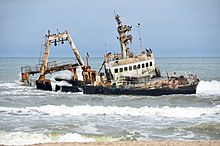

Skeleton Coast
| |
|---|---|
Coast
| |

Otavi, shipwrecked 1945
| |
| Coordinates: 21°36′44″S 14°32′24″E / 21.61222°S 14.54000°E / -21.61222; 14.54000 | |
| Location | Namibia |
| Part of | Namib Desert coast |
| Offshore water bodies | Atlantic Ocean, Kunene River, Swakop River |
| Etymology | Named for whale and seal bones that used to litter the coast, partly due to whaling, and for the thousands of shipwrecks |
| Dimensions | |
| • Length | 310 miles (500 km) |
The Skeleton Coast is the northern part of the Atlantic coast of Namibia. Immediately south of Angola, it stretches from the Kunene River to the Swakop River, although the name is sometimes used to describe the entire Namib Desert coast. The indigenous San people (formerly known as Bushmen), of the Namibian interior called the region "The Land God Made in Anger", while Portuguese sailors once referred to it as "The Gates of Hell".
On the coast, the upwelling of the cold Benguela current gives rise to dense ocean fogs (called cassimbo by the Angolans) for much of the year. The winds blow from land to sea, rainfall rarely exceeds 10 millimetres (0.39 in) annually, and the climate is highly inhospitable. There is a constant, heavy surf on the beaches. In the days before engine-powered ships and boats, it was possible to get ashore through the surf, but impossible to launch from the shore. The only way out was by going through a marsh hundreds of kilometres long and only accessible via a hot and arid desert.
The coast is largely made up of soft sand occasionally interrupted by rocky outcrops. The southern section consists of gravel plains, while north of Terrace Bay the landscape is dominated by high sand dunes.
Skeleton Bay is known as a great location for surfing. The Salty Jackal, a backpackers lodge located in Swakopmund, and Surf Guide Namibia, a local tour guide and surf school are currently the only groups that run guided surf trips along the Skeleton Coast.[1]

The area's name derives from the whale and seal bones that once littered the shore, partly due to the whaling industry, although in modern times the coast also harbours the skeletal remains of the shipwrecks caused by offshore rocks and fog.[2] More than a thousand such vessels of various sizes litter the coast, notably the Eduard Bohlen, Benguela Eagle, Otavi, Dunedin Star and Tong Taw.
The name "Skeleton Coast" was coined by John Henry Marsh as the title for the book he wrote chronicling the shipwreck of the Dunedin Star. Since the book was first published in 1944, it has become so well known that the coast is now generally referred to as "Skeleton Coast" and is named so on most maps today. See § In popular culture, below.

One of the oldest shipwrecks in the Skeleton Coast region is that of the Bom Jesus, near the town of Oranjemund. It ran aground during the 1530s and is known to be one of the oldest discovered shipwrecks of the Iberian Atlantic tradition in Sub-Saharan Africa.[3] On Thursday, 22 March 2018, a Japanese registered fishing vessel, MVF Fukuseki Maru, got into trouble and ran aground near Durissa Bay, south of the Ugab River mouth, lying 2 km from the Skeleton Coast beach in the ocean. All 24 foreign crew members were rescued by Namibian authorities.[4]
Past human occupation by Strandlopers is shown by shell middens of white mussels found along parts of the Skeleton Coast.
In 1942 the British refrigerated cargo liner Dunedin Star ran aground. All her 106 passengers and crew were eventually rescued, but at the cost of a tug, an SAAF aircraft and the lives of two rescuers. The account is recorded in a book Skeleton Coast by John Henry Marsh.

Namibia has declared the 16,000 square kilometres (6,200 sq mi) area of coastline and adjacent deserts, scrub and marshlands as Skeleton Coast National Park, from the Ugab River to the Kunene. The northern half of the park is a designated wilderness area. Notable features are the clay castles of the Hoarusib River, the Agate Mountain salt pans, and the large brown fur seal colonies at Cape Fria. The remainder of the coast is the National West Coast Recreation Area. The national park is part of the Iona – Skeleton Coast Transfrontier Conservation Area.[5]
The coast has been the subject of a number of wildlife documentaries, particularly concerning adaptations to extreme aridity, such as the 1965 National Geographic documentary Survivors of the Skeleton Coast.[6] Many of the native species of succulent plants depend on the thick sea fogs, which roll-in from the coast, for their moisture; in addition to water droplets for their hydration, windblown detritus from the arid interior serves as a food source for numerous invertebrates, which, in turn, feed the herpetofauna and form the base of the desert food chain. The desert bird assemblages have been studied in terms of their thermoregulation, coloration, breeding strategies and nomadism.
The riverbeds and flatlands further away from the beaches are home to bush elephants, Chacma baboons, southern giraffe, lions, leopard, black rhinoceros, spotted and brown hyenas, gemsbok and springbok, among many other species.[7] The animals get most of their water from wells dug by one another, in addition to consuming various water-laden succulent plants. The black rhinoceros population was the main reason why the CBBC show Serious Desert was filmed in the region.
Gallery
| International |
|
|---|---|
| National |
|
| Other |
|